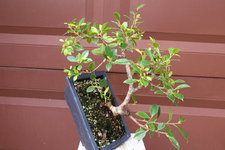pandacular
Omono
I have a few trees that will be getting repotted at a new, often quite different angle at the next opportunity. Until repot, does it make sense to keep the pot at the new inclination?
I have seen that some professionals seem to do this, but it's not necessarily consistent. I've also seen some people post pictures of trees with their pots situated at a specific angle within another pot, in a manner that looks more permanent than just a photoshoot.
The benefits I see to inclining the pot are allowing the plant to reposition it's foliage through phototropism, as well as just getting to view it at it's future angle. A potential downside is that it could potentially impact the drainage, similar to how chocking a pot during heavy rain lowers the water table.
What do you do with your plants that are due to be repotted at a different angle?
I have seen that some professionals seem to do this, but it's not necessarily consistent. I've also seen some people post pictures of trees with their pots situated at a specific angle within another pot, in a manner that looks more permanent than just a photoshoot.
The benefits I see to inclining the pot are allowing the plant to reposition it's foliage through phototropism, as well as just getting to view it at it's future angle. A potential downside is that it could potentially impact the drainage, similar to how chocking a pot during heavy rain lowers the water table.
What do you do with your plants that are due to be repotted at a different angle?

